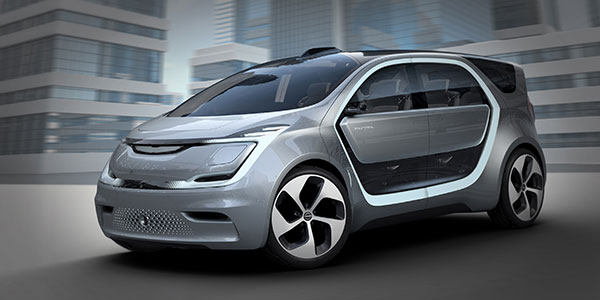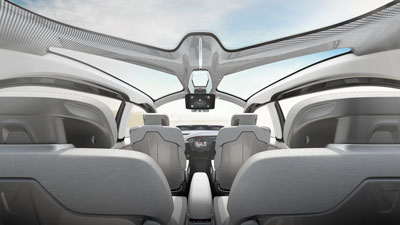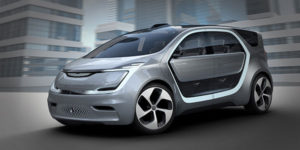
When it came to thinking about the future of family transportation, FCA US called upon the people who will own and live with such a vehicle – millennials working inside the company’s design and engineering functions – to collaborate on ideas. Armed with research on what the millennial generation values and desires, the team created a forward-thinking interpretation of the “fifth generation” of family transportation – the Chrysler Portal concept, created by millennials for millennials.
Millennials are tech savvy, environmentally aware and cost conscious. To balance those needs and to be an integral part of millennials’ lives, the Chrysler Portal concept is designed to maximize interior space with an impressive degree of flexibility between seating and cargo configurations; to enable users to include and expand their social media communities with seamless wireless integration between the vehicle and mobile devices; to take advantage of technologic advances in battery-electric powertrains and the growth of a rapid recharging network; and to deliver these capabilities in a powerful, high-tech form that uses LED lighting as a key design element, and not as a mere accent.
“The Chrysler Portal concept is backed by significant research on the millennial generation,” said Tim Kuniskis, head of passenger car brands – Dodge, SRT, Chrysler and FIAT, FCA – North America. “Millennials have clearly defined that they want a vehicle that will grow with them as they experience life changes.”
Millennials in the Millions
While millennials are a broad group of consumers at varying life stages, the Chrysler Portal concept is designed and engineered with all life stages and lifestyles in mind, including active/adventure, single, married/partnered, those with newborns and older children.
The Chrysler Portal concept explores the possibility of what a family transportation vehicle could look like for the millennial generation as their lifestyles evolve. The flexibility, adaptability and technology features also make it ideal for business and commercial applications, such as ride hailing, car sharing and delivery services.
Designed from the Inside, Chrysler Portal Concept Creates Third Space
Designed from the inside out, the interior of the Chrysler Portal concept offers the driver and passengers a “third space” – an open and serene atmosphere that provides an alternative environment between work and home.
Spacious and modern, the interior features soft, clean, sculptural lines that are colored in a mix of neutral and grey hues accented by jewel tones; the interior space takes advantage of a tasteful and elegant mix of textures and materials.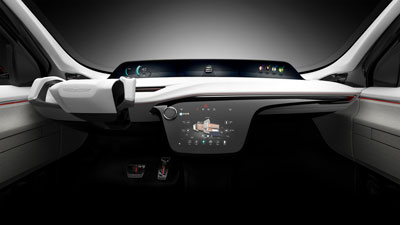
Premium seating is standard for all occupants with thin-design seats that fold flat, fold up and slide fore/aft on a track system for ultimate flexibility. The seats mount to tracks embedded in the floor. This enables the seats to move the full length of the vehicle and, if needed, to be removed easily from the rear of the vehicle.
Battery-electric vehicle technology contributes to cabin spaciousness with a minimized engine compartment and a low, flat-load floor atop the battery pack that is ideal for transporting people and equipment for an active lifestyle.
Technology is celebrated throughout with a clean, simple high-mount instrument panel display with easy-to-use interfaces. Screens can be positioned throughout the interior for ultimate passenger engagement.
Up to eight docking stations, located in the instrument panel and seats, can be used for charging and securing mobile phones and tablet devices.
Exterior Design Centers Around Portal Doors
The Chrysler Portal concept takes a new perspective with a clean, simple yet strong design statement amplified by refined lines along the body and a strong, planted stance.
Featuring a mono-volume form that “shrink wraps” the battery-electric vehicle (BEV) powertrain and interior packaging, the Portal’s exterior design is anchored by illuminated, portal-shaped side openings with articulating front and rear doors for easy loading and unloading of people and cargo.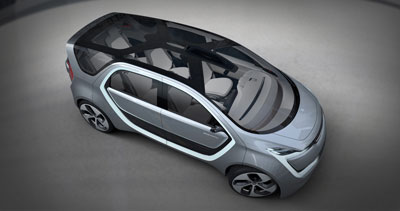
The lighting on the Chrysler Portal concept is an interactive experience, as well as a communication tool. The vehicle is equipped with full-color, changing LED lighting on the front, side portals and rear. Not only can the light take on different colors, it can have a swiping or animated appearance. Interactive ground projection and portal lighting are available in infinite colors that can be tailored for personal, business or drive settings, such as when the vehicle is parked, locked/unlocked or in autonomous mode.
The headlamps and tail lamps feature next-generation Thin Lens LED technology with an adaptive driving beam to provide increased safety through improved visibility.
A full-length clear polycarbonate roof panel visually expands the vehicle’s interior space and admits natural light to all occupants.
Engineered for Future Developments
An all-electric vehicle, the Chrysler Portal concept is propelled by a single electric motor driving the front wheels. A lithium-ion battery pack, rated at around 100 kWh, is integrated into the vehicle underbody, which increases structural rigidity and provides a low center of gravity, which enhances handling and ride comfort. The Chrysler Portal concept is estimated to have more than 250 miles of range on a full charge.
The integrated charging port, located at the front of the vehicle, uses the industry-accepted Combined Charging System (CCS) plug for energy and communication between the vehicle and charging equipment. DC Fast Charging at 350 kW enables the battery pack to be recharged for 150 miles of range in less than 20 minutes. The Chrysler winged badge on the front fascia serves as a charging indicator light.
The Chrysler Portal concept is capable of SAE Level Three semi-autonomous operation and the driver has the option to turn driving control over to the vehicle under certain highway driving situations. The vehicle is equipped with an array of sensor technologies (LIDAR/radar/sonar/vision) that constantly monitor conditions outside and inside the vehicle. The Chrysler Portal concept is engineered to upgrade to higher levels of autonomy as technology progresses, and if the owner is interested in adding it to their vehicle.
Adaptable User Experience Anticipates Needs
There are more than 20 available technologies designed to engage, inform and connect the driver and passengers. The Chrysler Portal concept provides an adaptable and upgradeable user experience that anticipates the needs and can evolve with lifestyle changes and technology advancements.
Infotainment, sensor and software systems are designed to provide a seamless user experience, including these key features:
- Facial recognition and voice biometrics recognize the user and are able to customize individual or family settings to provide a unique drive experience based on preferred features, such as exterior and interior lighting, favorite music, enhanced audio settings, favored destinations and more;
- Vehicle-to-X (V2X) communication enables the vehicle and infrastructure to “talk” to each other, such as intersection crash warning, traffic sign recognition and emergency vehicle approaching;
- Personal Zoned Audio keeps the driver aware of surroundings by enhancing sound and directionality in the event of approaching emergency vehicles;
- Seamless vehicle integration of personal devices, such as phones, tablets, cameras and wearables; and
- Community sharing enables passengers to share music, images, videos and more with other passengers.
Visit the Chrysler Portal concept microsite.
Source: FCA US

